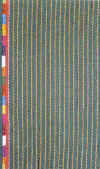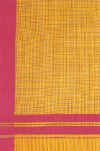|
|
|
||||
|
APRIL 2002 Contents
Travel 'Baikunth'
- the mountain Literature Visual Arts Jatin
Das - 4 decades of Music Zakir
Hussain - Compelling Hakim
Ajmal Khan's ancestral Business & Economy Performing Arts 'Fakir
of Benares' -1922 French Films Revathy
Menon's 'Mitr - my Books 'Knock
at Every Alien Door' People
Books
|
|
|
|||
| print gallery | |||||
|
Page 2 of 4
Textiles of Pakistan - Past & Present (cntd) by Shehnaz Ismail.
Silk weaving is mentioned as early as the third century BC and subsequent rulers encouraged the weaving of silk and its cultivation throughout their reigns. However, it was with cotton that the genius of the weaver, printer and embroiderer found its richest and boldest expression. The traditions were passed from father to son, similar to the guild organizations in medieval Europe. This system encouraged craft specialization, which survived thousands of years and age of prosperity, trade and power fueled a thriving handicraft industry especially in the realm of textile arts. In parts of the Old World, Indian fabrics were proverbial. In Nero’s time translucent muslins were fashionable in Rome, known as "woven winds" or " woven air". For the coveted togas, Pliny complains, Romans drained the gold coffers of Rome. The record of trade of Indian textiles to south east Asia reaches back as early as the 5th century to documents that record an Indonesian diplomatic mission to China that "carried textiles from India and Gandhara". Cave paintings found in Ajanta [ 5th century AD] show murals, a vital document of influence of royal patronage of the textile arts of that period, where figures are shown wearing clothing with stripes, checks, chevrons, and birds such as peacock and geese. These were most likely stamped and dyed textiles. Beginning in the 8th century a series of Muslim incursions [starting with Mohammed Bin Qasim - AD 712] led to the first Muslim kingdom under Qutbuddin Aibak. Arab ships blown by monsoon winds sailed across the Indian Ocean to trade in India Textiles. Along with these routes, came another religion to India- Islam. The Sultans of Delhi 1206-1555, principal architects of Muslim rule in India, maintained their sovereign status by consistently fighting a three-pronged battle for political stability, economic regeneration and social synthesis. In order to maximize production, conditions were created to shift the craftsmen from rural or semi-rural habitats to urban precincts, which had better infrastructure to facilitate the buying of raw materials and marketing the finished goods. Craft and agriculture constituted the entire spectrum of the medieval productive activities of the realm. Treatises and trade documents list export items, which included indigo, madder dyed chintz and dyed silken goods. Textile crafts began to flourish with an influx of craftspeople from Central Asia. Production of silk goods was restricted to Kashmir and Bengal and in the rest of the country silk yarn was imported from Persia, Khurasan, Turkey and China. The Sultans imported raw silk, and silk weavers from the overland route of the northwestern passes. A domestic market was created for silken goods and Delhi, Cambay , Pattan and Ahmedabad became the urban centers of silk craft. Over a period of time cotton was mixed with silk to create Mashru, a double layered material with a thick cotton base and a silken warp woven in satin weave, a purely Indian innovation. It was woven specially for the Muslim male, as it was sacrilegious for him to wear silk. In the Mashru weave [meaning permitted in Arabic], the cotton weft lay against the skin, hence it was permissible to wear it. In the Ain-i Akbari, it is mentioned that Susi , a reputed silken fabric from Shush, a town in Persia, was originally brought to the Deccan via Alexandria during the 11th century. In the subsequent centuries it had lost its silken character somewhere along the line and reappeared as a cotton fabric in Lahore in the 1620’s. Susi later became synonymous with Sindh, the primary production centers being Thatta, Hala and Hyderabad. Technological improvements were gradually introduced such as the spinning wheel [charkha] and treadle [pai-chah] in the weavers’ loom, to increase refinement in designing, dyeing and printing by block. Painting process amounted for a much higher volume of output. The rise and blossoming of Islamic culture under the Mughals stimulated European interest in India. In the 16th century Queen Elizabeth I sent the first European envoys to the court of Akbar the Great, whose power and splendor dwarfed her own. In 1600 the British, French, and Dutch established East India trading companies and so began the history of trade in textile goods. The refined, lightweight, colorful, washable fabrics from India became a luxury for people used to only woolens and linens of the age. Cotton chintz [chitta or cheent] became synonymous with a range of muslins and painted cloth. The availability of fine cotton textiles ultimately affected industry throughout Europe. It shook governments and changed fashions.
|
|||||
| Copyright © 2000 [the-south-asian.com]. Intellectual Property. All rights reserved. | |||||
| Home | |||||



